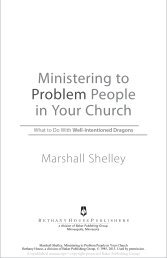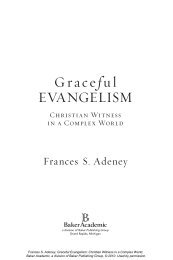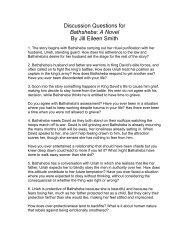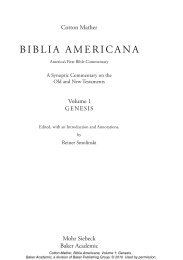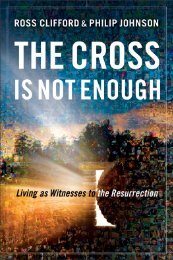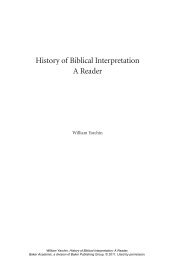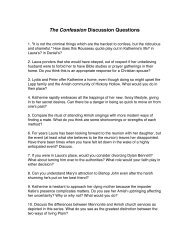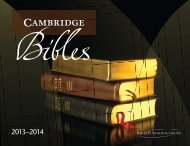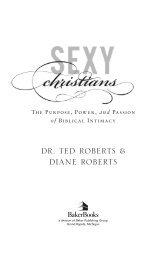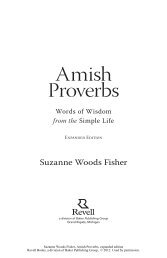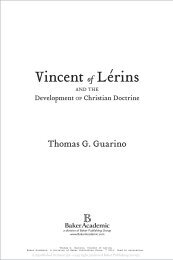the gospel of mark a commentary - Baker Publishing Group
the gospel of mark a commentary - Baker Publishing Group
the gospel of mark a commentary - Baker Publishing Group
Create successful ePaper yourself
Turn your PDF publications into a flip-book with our unique Google optimized e-Paper software.
14 THE GOSPEL OF MARK<br />
early Christian church: false prophets (see 13:5–6; 21–22), wars and rumors <strong>of</strong> wars (see<br />
13:7, 14–20), events that took place at <strong>the</strong> fall <strong>of</strong> <strong>the</strong> temple (13:14). Mark 13 is “ra<strong>the</strong>r like a<br />
window which allows a close view <strong>of</strong> Markan circumstances.” 56 The Gospel <strong>of</strong> Mark must<br />
have reached its final shape in <strong>the</strong> period just after 70 C.E., as <strong>the</strong> horror and significance <strong>of</strong><br />
<strong>the</strong> destruction <strong>of</strong> Jerusalem and its temple made its impact upon <strong>the</strong> Markan community. 57<br />
These three elements leave us with some hard facts, which can, in turn, lead to a suggestion<br />
(which never<strong>the</strong>less remains speculative) about <strong>the</strong> time and <strong>the</strong> place <strong>of</strong> <strong>the</strong> Gospel<br />
<strong>of</strong> Mark. I would regard <strong>the</strong> following details as hard facts:<br />
1. The author is familiar with <strong>the</strong> Roman world, its language, and its mode <strong>of</strong> government.<br />
2. The author and <strong>the</strong> community for whom he was writing were concerned about <strong>the</strong> mission<br />
to <strong>the</strong> Gentiles.<br />
3. The community is exposed to suffering and persecution, and its members are probably discouraged<br />
by <strong>the</strong> failure <strong>of</strong> some to commit <strong>the</strong>mselves, unto death, to <strong>the</strong> <strong>gospel</strong> <strong>of</strong> Jesus<br />
Christ. 58<br />
4. The Gospel was written shortly after <strong>the</strong> fall <strong>of</strong> Jerusalem in 70 C.E.<br />
The traditional location <strong>of</strong> Rome has much to <strong>of</strong>fer, but <strong>the</strong> background <strong>of</strong> <strong>the</strong> fall <strong>of</strong> Jerusalem<br />
to Mark 13 suggests a location closer to <strong>the</strong>se events. Were <strong>the</strong> Roman Christians in<br />
need <strong>of</strong> severe warnings not to listen to false prophets, rising up in <strong>the</strong> midst <strong>of</strong> <strong>the</strong> postwar<br />
chaos to declare that <strong>the</strong> end time had come (see 13:5–6, 21–22)? Was it necessary to<br />
tell Roman Christians, who lived at <strong>the</strong> center <strong>of</strong> <strong>the</strong> known world, that <strong>the</strong>y must calm<br />
<strong>the</strong>ir apocalyptic fever because before <strong>the</strong> final coming <strong>of</strong> <strong>the</strong> Son <strong>of</strong> Man <strong>the</strong> <strong>gospel</strong> must<br />
be preached to all <strong>the</strong> nations (see 13:10)? How real were all <strong>the</strong> threats <strong>of</strong> 13:11: “They will<br />
deliver you up to councils; and you will be beaten in synagogues; and you will stand before<br />
governors and kings for my sake” (13:9)? 59 The Gospel <strong>of</strong> Mark never creates <strong>the</strong> impression<br />
that <strong>the</strong> storyteller and <strong>the</strong> community receiving <strong>the</strong> Gospel had a special interest in<br />
Strong Man, 39–87) dates <strong>the</strong> Gospel between 68–70. He determines this date through a number <strong>of</strong><br />
sociocultural reflections that depend, on <strong>the</strong> one hand, on speculations about <strong>the</strong> situation <strong>of</strong> Palestine<br />
during those turbulent years, and on <strong>the</strong> o<strong>the</strong>r, through a reconstruction <strong>of</strong> ideological and social<br />
strategies that appear to have been established with one eye on <strong>the</strong> Gospel <strong>of</strong> Mark and <strong>the</strong> o<strong>the</strong>r<br />
on <strong>the</strong> relevance <strong>of</strong> <strong>the</strong> Gospel for <strong>the</strong> post-Reagan era in <strong>the</strong> United States. For an alternative reading<br />
<strong>of</strong> <strong>the</strong> pre-70 period in Palestine, see J. McLaren, Turbulent Times? Josephus and Scholarship on<br />
Judea in <strong>the</strong> First Century C.E. (JSPSup 29; Sheffield: Sheffield Academic Press, 1998). As Myers confesses:<br />
“This discussion has been intended to make <strong>the</strong> notion <strong>of</strong> socio-symbolic codes, so crucial to<br />
a political understanding <strong>of</strong> <strong>the</strong> Gospel, more meaningful to <strong>the</strong> reader” (p. 72). I suspect that <strong>the</strong><br />
evangelist’s agenda may be playing second fiddle to Myers’s sociopolitical commitment.<br />
56W. Kelber, TheKingdominMark:ANewPlaceandaNewTime(Philadelphia: Fortress,<br />
1974), 110.<br />
57Myers’s claim for a pre-70 dating, in his <strong>commentary</strong> on Mark 13 (see Binding <strong>the</strong> Strong<br />
Man, 324–53), is not supported by a satisfactory explanation <strong>of</strong> such crucial texts as 13:14 (“<strong>the</strong> desolating<br />
sacrilege where it ought not to be”). Interestingly, Myers’s radical reading <strong>of</strong> Mark turns at this<br />
point to <strong>the</strong> conservative work <strong>of</strong> J. A. T. Robinson (Redating <strong>the</strong> New Testament [London: SCM,<br />
1976], 16) to speak vaguely <strong>of</strong> <strong>the</strong> siege <strong>of</strong> Jerusalem (see p. 335). On <strong>the</strong> importance <strong>of</strong> 13:14, see<br />
D. Lührmann, Das Markusevangelium (HNT 3; Tübingen: J. C. B. Mohr [Paul Siebeck], 1987), 5–6,<br />
and <strong>the</strong> full-scale study <strong>of</strong> W. A. Such, The Abomination <strong>of</strong> Desolation in <strong>the</strong> Gospel <strong>of</strong> Mark: Its Historical<br />
Reference in Mark 13:14 and Its Impact in <strong>the</strong> Gospel (Lanham: University Press <strong>of</strong> America, 1999).<br />
58See Marcus, Mark, 28–29.<br />
59Ernst (Markus, 21–22) hesitatingly opts for Rome as <strong>the</strong> place <strong>of</strong> its origin, but on pp. 22–23<br />
correctly points to Mark 13 as <strong>the</strong> key to <strong>the</strong> issue <strong>of</strong> when it was written, some time shortly after 70.<br />
The time (after <strong>the</strong> destruction <strong>of</strong> Jerusalem) and <strong>the</strong> place (Rome?) need to be held toge<strong>the</strong>r.<br />
Francis J. Moloney<br />
<strong>Baker</strong> Academic, a division <strong>of</strong> <strong>Baker</strong> <strong>Publishing</strong> <strong>Group</strong>, © 2002. Used by permission.




